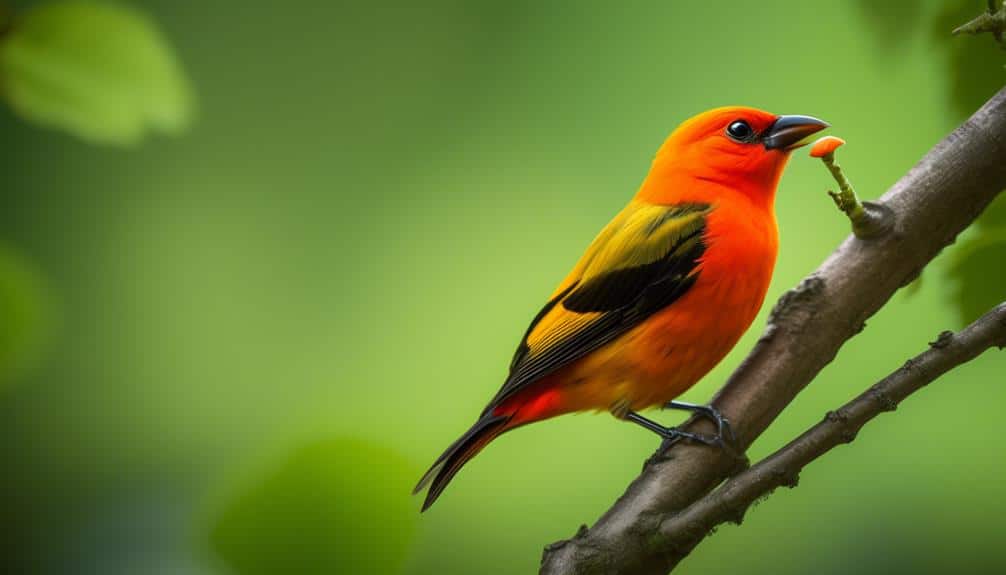As I strolled through the verdant forests of Michigan, I couldn't help but notice a peculiar sight – a flash of vibrant orange amidst the sea of green. Curiosity piqued, I found myself wondering about the presence of these orange birds in the Great Lakes State.
What species are they? Where do they come from? And why are they becoming more prevalent in this region?
Join me on this exploration as we unravel the mysteries surrounding these colorful creatures and uncover the secrets of their existence in Michigan.
The Vibrant Colors of Orange Birds
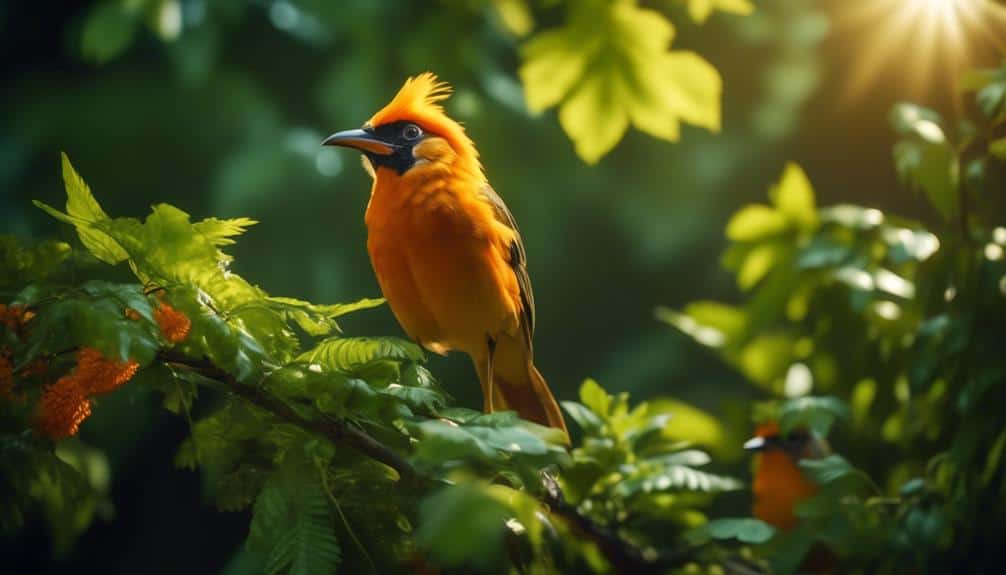
Orange birds are known for their striking and vibrant plumage, which captivates observers with its brilliant hue. The color symbolism of orange birds is quite intriguing. In nature, orange is often associated with warmth, energy, and enthusiasm. It symbolizes vitality and excitement, making orange birds a captivating sight in their natural habitats.
The role of orange birds in pollination is also significant. Many orange birds, such as orioles and tanagers, feed on nectar from flowers. As they visit various flowers in search of food, these birds inadvertently transfer pollen from one flower to another. This process, known as pollination, is crucial for the reproduction of plants. Without the assistance of orange birds and other pollinators, many plant species would struggle to reproduce and maintain their populations.
In addition to their role in pollination, orange birds also contribute to the ecosystem in other ways. They help control insect populations by feeding on pests, which can benefit agricultural crops and reduce the need for chemical pesticides. Moreover, their vibrant colors and melodious songs enhance the overall beauty and biodiversity of the environment.
Identifying Michigan's Orange Avian Species
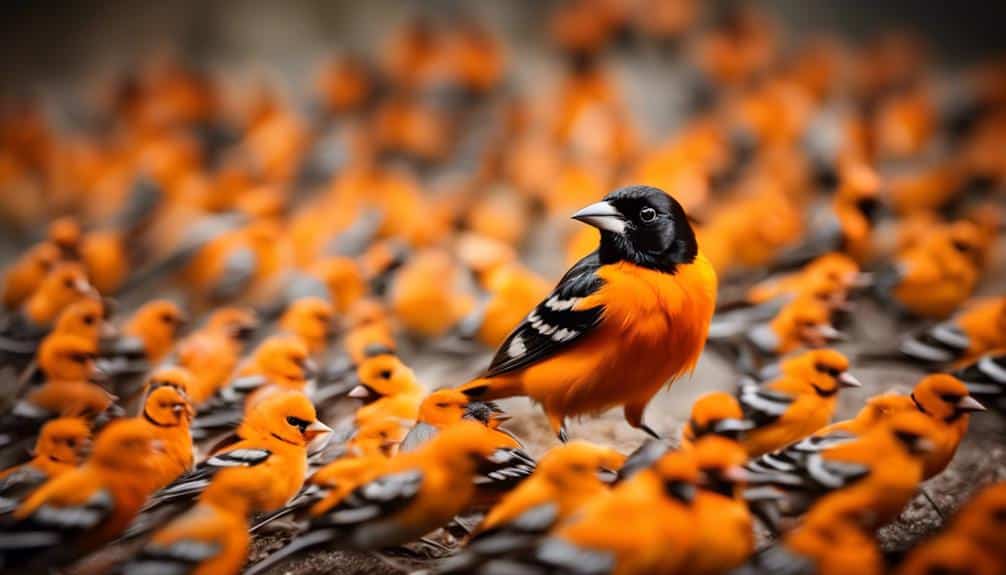
As an avid birdwatcher in Michigan, I'm always fascinated by the diverse avian species that inhabit our state, and when it comes to identifying the orange birds that grace our skies, there are several distinct species that stand out.
Michigan is home to a variety of birds with orange plumage, and with a keen eye and some birdwatching tips, you can easily identify them.
One common orange bird found in Michigan is the Baltimore Oriole (Icterus galbula). These birds have bright orange plumage, with black wings and a black head. They can often be spotted in open woodlands or near wetlands, where they build their hanging nests.
Another orange bird that frequents Michigan is the American Robin (Turdus migratorius). While their breast is typically red-orange, they also have a gray back, black head, and white eye ring. Robins are commonly found in residential areas and can be recognized by their melodious song.
Lastly, the Northern Cardinal (Cardinalis cardinalis) is a stunning orange bird that can be seen throughout Michigan. The male cardinal is a vibrant red-orange, while the female has a more muted orange plumage. These birds are often found in gardens and wooded areas and can be identified by their distinctive crest and strong beak.
When identifying orange birds in Michigan, it's important to observe their size, shape, habitat, and behavior. By paying attention to these details and using birdwatching tips, you can become an expert at identifying the different orange avian species that grace our state.
Exploring the Habitats of Orange Birds

The habitats of orange birds in Michigan vary based on their specific species and ecological preferences. Orange birds exhibit a range of behaviors and can be found in various habitats throughout the state. Here are some key points to consider:
- Forests: Many orange bird species, such as the Baltimore oriole (Icterus galbula), prefer nesting in deciduous forests with a mixture of tall trees for nesting and open areas for foraging. These birds are known for their vibrant orange plumage and melodious songs.
- Wetlands: Some orange birds, like the Northern flicker (Colaptes auratus), can be found in wetland areas where they can excavate cavities in trees for nesting. These birds have a unique combination of orange on their underparts and a black-spotted plumage.
- Grasslands: The American goldfinch (Spinus tristis) is a common orange bird species in Michigan often found in grasslands and open fields. These birds are known for their bright orange plumage during the breeding season.
- Urban areas: Orange birds, like the house finch (Haemorhous mexicanus), have successfully adapted to urban environments. They can be found in parks, gardens, and residential areas, bringing a splash of orange to city landscapes.
Understanding the distribution and behavior of orange bird species in different habitats is crucial for conservation efforts and ensuring their long-term survival in Michigan.
Migration Patterns of Michigan's Orange Feathered Friends
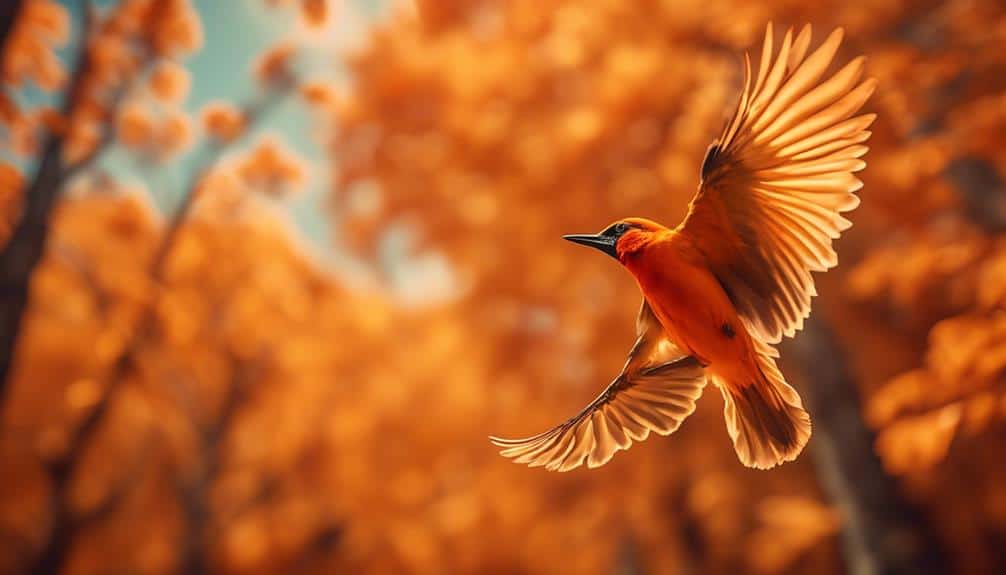
During their annual migratory journeys, orange bird species in Michigan navigate vast distances to reach their seasonal habitats. The migration patterns of these birds are influenced by a combination of factors, including food availability, weather conditions, and breeding requirements. Understanding these patterns can provide valuable insights into orange bird behavior and population trends.
Orange birds in Michigan typically begin their migration in the spring, when the weather becomes milder and food sources become more abundant. They travel in flocks, following well-established routes known as flyways. These routes often span thousands of miles, with some birds traveling from as far as Central and South America to reach their summer breeding grounds in Michigan.
Migration is a challenging and perilous journey for orange birds. They must navigate through unfamiliar territories, face potential predators, and overcome various environmental obstacles. Some orange bird species rely on landmarks and instinctual cues, while others use the Earth's magnetic field to navigate.
Monitoring orange bird migration is crucial for understanding population trends and conservation efforts. By tracking their movements and analyzing their behavior during migration, scientists can identify important stopover sites, assess habitat quality, and identify potential threats. This information can help guide conservation efforts and ensure the long-term survival of these beautiful orange feathered friends.
Possible Reasons for the Increase in Orange Birds

One possible explanation for the increase in orange birds in Michigan could be the availability of suitable breeding habitats. The impact of climate change on the orange bird population may have also played a significant role. Here are some reasons for the surge in orange birds:
- Increased availability of food sources: With climate change causing shifts in ecosystems, certain plants and insects that orange birds rely on for food may be more abundant in Michigan now. This could attract more orange birds to the region.
- Expanded breeding range: As the climate warms, the suitable breeding range for orange birds may have expanded northward, allowing them to establish populations in Michigan where they were previously rare or absent.
- Habitat modifications: Changes in land use practices, such as the creation of more open spaces or the planting of specific vegetation types, may have inadvertently created suitable breeding habitats for orange birds in Michigan.
- Migration patterns: Orange birds may be altering their migration patterns in response to changing climate conditions. Some individuals may now choose to overwinter in Michigan instead of migrating further south, leading to an increase in their population.
Understanding the reasons behind the increase in orange birds is crucial for conservation efforts. Further research is needed to confirm these hypotheses and develop effective strategies to protect and manage their populations in Michigan.
Conservation Efforts for Michigan's Orange Avifauna
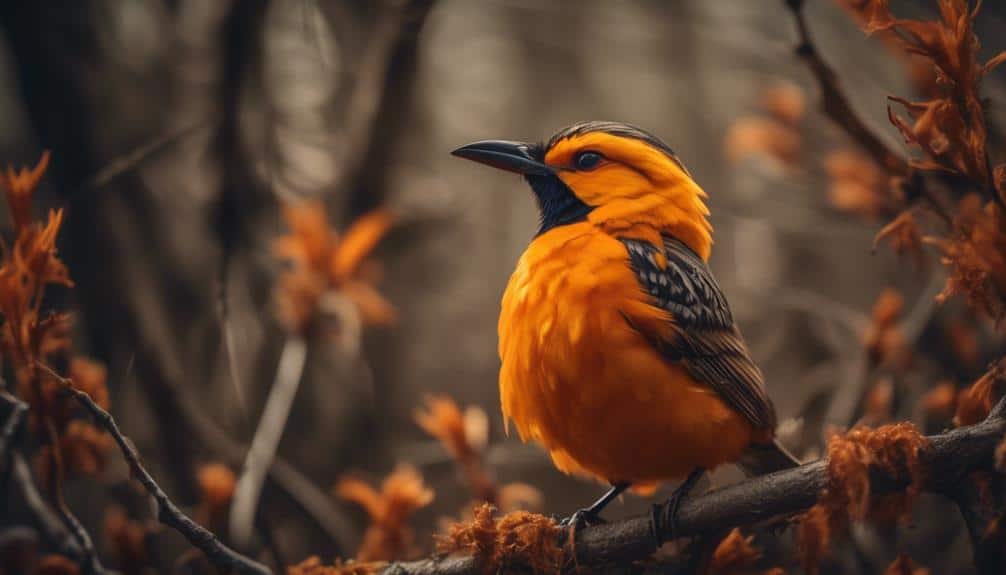
In order to effectively conserve Michigan's orange avifauna, it's essential to implement targeted strategies based on a thorough understanding of their habitat requirements and population dynamics. Conservation strategies should focus on preserving and restoring the specific habitats that these birds rely on, such as wetlands, forest edges, and meadows. It's crucial to maintain the diversity of plant species within these habitats, as well as providing ample food resources and nesting sites.
Additionally, efforts should be made to reduce threats to these birds, such as predation, habitat loss, and climate change.
Population monitoring plays a vital role in conservation efforts. By regularly monitoring the population sizes and trends of orange avifauna species, scientists and conservationists can assess the effectiveness of their strategies and make necessary adjustments. This can be achieved through various methods, including bird surveys, nest monitoring, and the use of remote sensing technologies.
Long-term monitoring allows for the detection of changes in population size, breeding success, and habitat quality, enabling targeted conservation actions.
Frequently Asked Questions
How Many Species of Orange Birds Can Be Found in Michigan?
In Michigan, there are several species of orange birds. They have varying average lifespans and habitat preferences. It is fascinating to observe these colorful creatures in their natural environment.
What Is the Average Lifespan of Orange Birds in Michigan?
The average lifespan of orange birds in Michigan varies depending on factors such as food availability, predation, and habitat quality. Additionally, habitat loss has had a detrimental impact on the population of orange birds in the state.
Are Orange Birds More Commonly Found in Specific Regions of Michigan?
Orange birds in Michigan are more commonly found in specific regions due to their preferred habitats, behavior, and diet. Factors influencing their orange coloration include genetics, diet, and environmental conditions.
Do Orange Birds Migrate to Other States During Certain Seasons?
Yes, orange birds do change their feather color during migration. This adaptation helps them blend into different environments. They also have physiological mechanisms to cope with varying climates during their migratory journeys.
Are There Any Endangered or Threatened Orange Bird Species in Michigan?
Yes, there are endangered orange bird species in Michigan. Conservation efforts are being made to protect these birds and their habitats. It is crucial to ensure their survival and maintain the biodiversity of Michigan's ecosystem.
Conclusion
In conclusion, the presence of orange birds in Michigan has sparked curiosity among bird enthusiasts and researchers alike. These vibrant avian species, with their distinctive hues, add a splash of color to Michigan's rich avifauna.
The increase in orange birds could be attributed to various factors, such as changes in habitat and migration patterns. It's crucial to continue studying and conserving these unique feathered friends to ensure their survival and maintain the biodiversity of Michigan's bird population.

